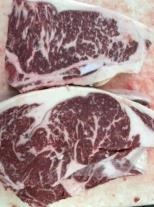By Haley Zynda
For those of you who eat beef, fat is flavor. For those of you feeding beef, fat is money. Well, a certain type of fat (intramuscular fat/marbling) is money because it increases your chance of selling higher quality grade beef. The three grades you’ll hear most often are prime, choice, and select, in descending order. Prime beef has abundant marbling and is currently only about 3% of the whole beef market. The intramuscular fat increases juiciness, tenderness and flavor of the meat cuts. Choice is most regularly seen in restaurants or grocery chains and select is the lowest grade commercially available in retail. Select grade beef has the least amount of marbling and is therefore less tender and juicy. If increasing quality grade is a goal of your operation, understanding how fat deposition occurs can be helpful in knowing how to best feed your cattle.

Propionate is the only fatty acid that can be converted to glucose in the liver and greater glucose production leads to greater average daily gains and marbling deposition.
Before getting into details, there are a few important distinctions to make. Intramuscular fat is marbling, the fat within the muscle. Subcutaneous fat is the fat under the skin; most likely you’ve heard this when discussing backfat thickness or the “bark” an animal has. Subcutaneous fat mainly increases through hypertrophy, the act of each fat cell getting larger in size. Marbling mainly accumulates through hyperplasia, the act of the fat cells multiplying without necessarily growing larger in size.
We know that both intramuscular and subcutaneous (sub-q) fat begin to deposit well before the calf is even born (Du et al., 2013) and this is mainly through hyperplasia – as the calf grows larger in the womb, the cells must continue to multiply for the fetus to fully develop. However, once the calf is born, hyperplasia of the sub-q fat tapers off and begins hypertrophy fat growth around 4 months of age. Hyperplasia of intramuscular fat cells continues until the animal is about 6.5 months old, meaning that until weaning we still have the opportunity to promote marbling fat deposition in our calves. It’s not until the animal is about a year old that all fat accumulation begins to occur in the manner of hypertrophy. Therefore, trying to put marbling in a steer only after he hits the feedlot may be fruitless if the fat cells were not already established within the muscle.
What we feed cattle affects the way fat is deposited. Acetate is a product of rumen fermentation and is prevalent when a high forage diet is fed. Propionate, while also produced from a high forage diet, increases in production when more grain is fed. Acetate and propionate are both fatty acids, but propionate is the only fatty acid that can be converted to glucose in the liver. Greater glucose production from the liver leads to greater average daily gains and marbling deposition. The resulting daily gain and marbling achievements is one of the reasons why many cattle are finished on grain rather than grass.
Even though it seems straightforward, there are many other factors that affect fat deposition that researchers do not have a concrete grasp on yet. Site of fat deposition, enzymatic activity, vitamins, and minerals can all be underlying factors as to how fat accumulates.
One additional factor that receives attention is vitamin A. Vitamin A inhibits new fat cell formation and animals with greater marbling tended to have lower vitamin A concentrations in their blood (Adachi et al., 1999). Animals provided a lower vitamin A diet also did not show a decrease in their average daily gain, feed to gain ratio, hot carcass weight, or back fat. Therefore, elimination of supplemental vitamin A may not only increase meat quality, but also decrease costs.
A final thought to leave you with circles back to the fat deposition timeline. If we are still able to promote marbling fat cell accumulation up to and around weaning age, what can we do to lessen stress on the animal to ensure the maximum amount of energy is directed toward growth and development? Weaning stress in calves can decrease their feed intake and impair their immune system, setting them up for potential disease. If you can increase energy density of the feed and include vitamin E to support immune health at weaning, you can try to mitigate some of the ill effects that stress can have on carcass yield and quality.
In sum, fat deposition is a multi-faceted stage of development that is still being researched. Diet composition, such as grain inclusion and vitamin A concentration, can affect how fat is accumulated, but early environmental factors at weaning can affect how cattle finish months down the line.
Source : osu.edu